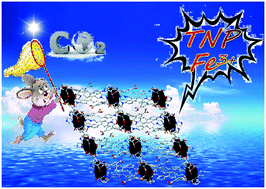Two tetranuclear Cd-based metal–organic frameworks for sensitive sensing of TNP/Fe3+ in aqueous media and gas adsorption†
Abstract
Two novel 3D Cd-MOFs, namely {[Cd4(HDDCP)2(4,4′-bibp)2(H2O)2]·2.5(DOA)·1.5(H2O)}n (1) and {[Cd2(HDDCP)(1,4-bib)(H2O)]·H2O}n (2), where H5DDCP = 2,4-di(2′,5′-dicarboxylphenyl)benzoic acid, 4,4′-bibp = 4,4′-bis(imidazolyl)biphenyl and 1,4-bib = 1,4-bis(1-imidazoly)benzene, have been solvothermally synthesized and structurally characterized by single crystal X-ray diffraction, elemental analysis (EA), thermogravimetric analysis (TGA) and infrared (IR) analysis. The structural analysis showed that 1 should be regarded as a complex 3D structure based on different 1D Cd–(COO) or Cd–(COO)–(COOH) rods as SBUs, and 2 was viewed as a complex 3D framework based on 1D Cd–(COO) rods as SBUs. MOFs 1 and 2 have good stability in boiling water, and alkaline/acidic aqueous solutions (pH = 4–10). The adsorption measurements indicated that the adsorption capacity of 1 for CO2 and CH4 is greater than that of 2, while the adsorption selectivity of 1 for CO2 is superior to that for CH4, which is attributed to the fact that 1 has a larger porosity and CO2 has characteristics such as a linear structure, larger polarizability and significant quadrupole moment. Furthermore, luminescence studies revealed that both 1 and 2 can be used as a highly selective and sensitive sensor for sensing TNP or Fe3+ ions in aqueous solution or soil samples, and the fluorescence quenching mechanism was explored in this work.



 Please wait while we load your content...
Please wait while we load your content...